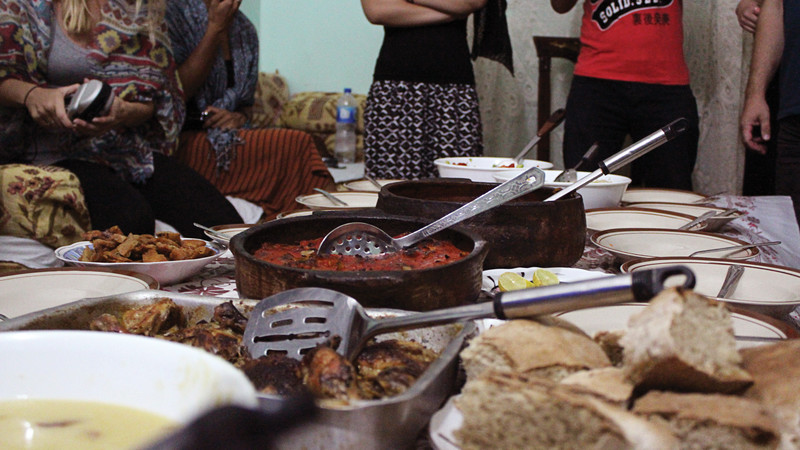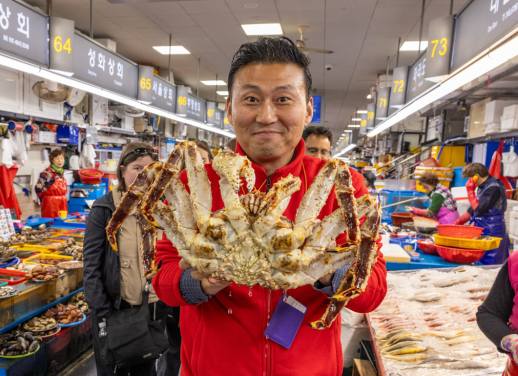While the average traveler could easily tell you some of the top tourist attractions in Egypt, few would be able to name just one quintessential Egyptian dish.
In fact, in all my travels, I’ve been hard-pressed to find Egyptian restaurants outside the country, leading me to believe that it’s a somewhat well-kept secret that hasn’t quite made it past the borders of the Mediterranean Sea…at least not yet.
After spending many summers in Egypt growing up, I can honestly say there are very few Egyptian dishes I haven’t tried. Egyptian cuisine shares similarities with its Mediterranean counterparts – but with a unique twist. While the food is oftentimes hearty, comprised mainly of legumes, vegetables, and meats, it’s just as easy to find access to fresh fruit and vegetables at one of the many outdoor markets. Forget about your fancy local farmer’s market – street markets are where the majority of Egyptians purchase fresh produce.
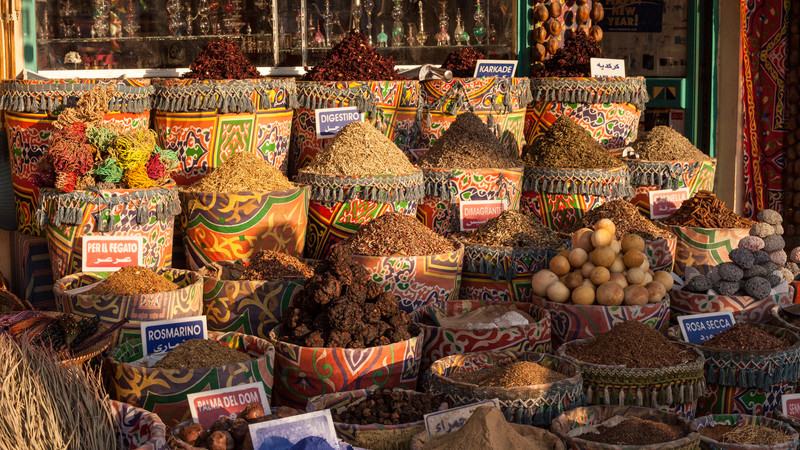
An Egyptian street market
Eating in Egypt doesn’t just mean a quick sandwich on the run. Rather, it’s a time for people to get together, enjoy each other’s company, and savor the aromatic flavors that come from an infusion of herbs and spices. And, with dishes that are as inexpensive as they are delicious, you’ll be sure to leave the country wondering how it took you so long to sample the food of the Pharaohs.
So bring your appetite and your eating pants with you to Egypt and be sure not to miss these six must-try dishes:
Koshary
Whenever someone mentions Egyptian food, the first dish that immediately comes to my mind is koshary. It’s so beloved by Egyptians that there are restaurants dedicated solely to serving this food coma-inducing dish. It consists of pasta, rice, lentils, garbanzo beans and fried onions and is topped with a tomato sauce. You can then customize the amount of hot sauce and da’ka (vinegar-garlic sauce) you want to add to the mix. Where to find the best koshary is hotly debated, but I still say Abou Tarek in downtown Cairo wins.
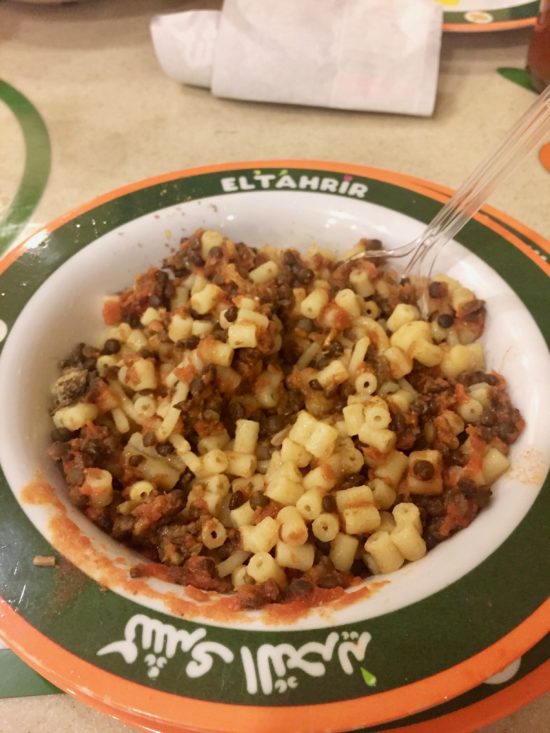
Koshary
Ful Mudammas
Although ful is most typically eaten for breakfast, it can be eaten pretty much any time of the day if you’re hungry enough. While ful mudammas is essentially mashed fava beans, what makes it shine is its versatility and customizable toppings. In Cairo, it’s most commonly made with garlic, cumin, lemon, and tahini. However, it can also be made with tomato sauce and vinegar, eggs and parsley, and more. It’s always served with piles of warm pita bread and is best eaten at one of the many ful carts dotting the streets of Cairo every morning.
READ MORE: CAIRO VS ALEXANDRIA: A GUIDE TO EGYPT’S TWO LARGEST CITIES
Fiteer Baladi
Egyptians often describe fiteer to foreigners as “Egyptian pizza,” which is close enough I suppose. This stone-fired bread is made with layers upon layers of filo dough and butter, and is definitely not a lightweight snack. Fiteer is oftentimes stuffed (rather than topped) with virtually anything, and is served in both savory and sweet forms.
There are many places to get fiteer, but I’m a personal fan of Fatatri El Tahrir, a little hole in the wall in Downtown Cairo that specializes in various types of fiteer.
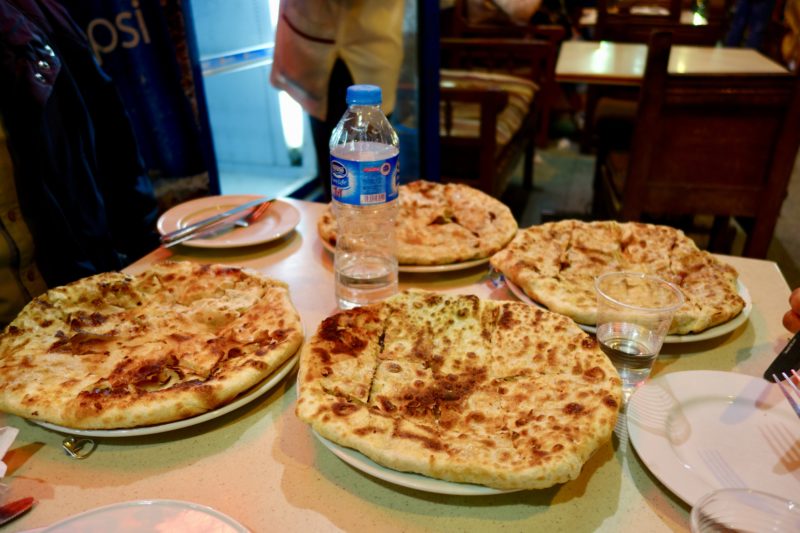
Fiteer Baladi
Ta’ameya
You might be wondering why ta’ameya looks a lot like falafel. That’s because it is (what’s in a name?). The only difference is that Egyptian ta’ameya is actually made of fava beans, rather than chickpeas. In my humble opinion, fava beans make ta’ameya much fluffier and moister than falafel, but the only way to know for sure is to taste it for yourself.
El Shabrawy – despite being a chain – hasn’t let me down to date.
CHECK OUT INTREPID’S RANGE OF SMALL GROUP TOURS IN EGYPT
Fattah
In case you aren’t seeing a trend here, Egyptians really like hearty, stick-to-the-bone dishes and fattah is no exception to that. So what is it and how is it made? First, bite sized pieces of pita bread are either baked or deep-fried until crispy. Add it to a bowl, and then add a bed of cooked rice on top, and scoop on a generous portion of sautéed beef. Top the dish with a garlic-tomato sauce and voilà: a simple, hearty, and delicious dish.
Fattah is best eaten homemade, but the version at Felfela is a close second.
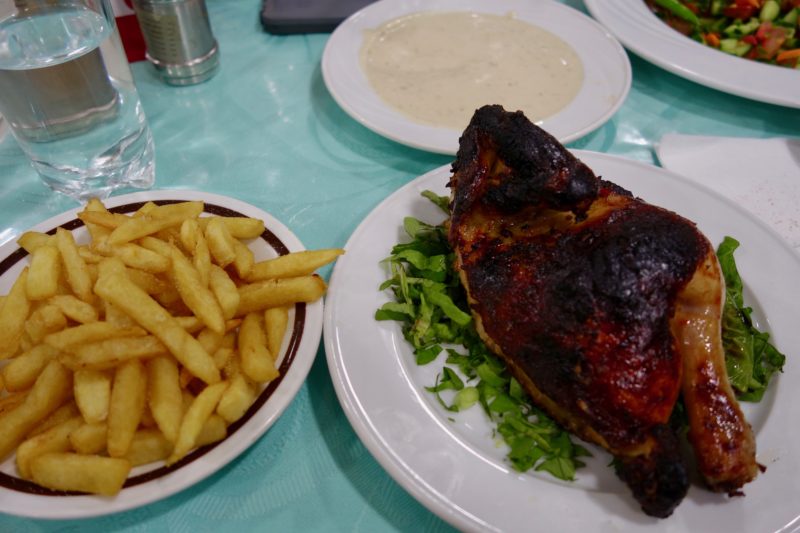
Did I mention how great value Egyptian food is? This meal cost $2!
Molokhia
Last, but certainly not least, is molokhia. Although typically eaten by royalty in ancient Egypt, in present times it’s a staple of every Egyptian kitchen. In English, the leafy green vegetable is known as mallow leaves, and it’s served as a thick stew, with a side of rice or bread, depending on preference.
While the dish may seem simple, every Egyptian knows that it’s easy to make a mess of molokhia. This might explain why when combining the herbs with the vegetable, the cook must gasp and say the Arabic translation of “green, green, green,” to ensure the dish comes out correctly (I’m serious). The traditional form of molokhia is served with rabbit, but nowadays it’s more common to eat it with chicken.
The version at Abou el Sid is well worth a try.
SUBSCRIBE TO INTREPID’S NEWSLETTER FOR TRAVEL TIPS, COMPETITIONS, GIVEAWAYS & MORE
Egyptian cuisine is diverse and unique, and I could have easily included another 10 dishes on this list. However, for the first time visitor, this is an excellent introduction to some of Egypt’s most well-known dishes.
If you love food, culture and adventure, Egypt is truly a destination not to be missed.
Ready to eat your way all around this awe-inspiring destination? Check out Intrepid Travel’s range of small group tours in Egypt.
—
(Image credits from top to bottom: Intrepid Travel x2, Sally Elbassir x3.)

